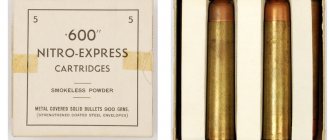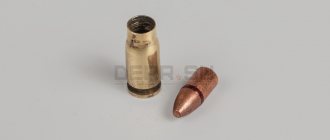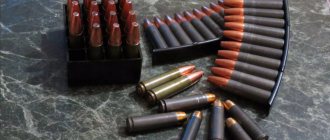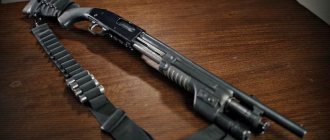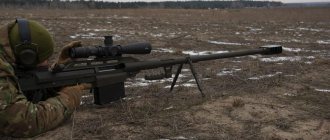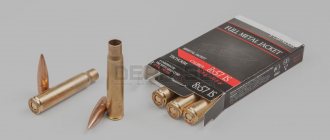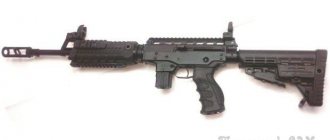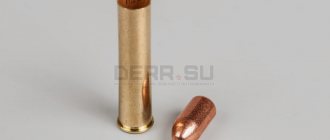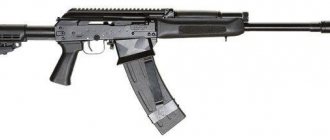The Pentagon is threatening to retire 5.56x45mm small-caliber machine gun cartridges (aka 5.56 NATO). The US military has already purchased about 1 million powerful experimental 6.8 mm ammunition for testing as part of the project to create weapons of the future NGSW (Next Generation Squad Weapons) - it should replace M4 carbines and M249 machine guns in the army. In 2022, the military department promises to purchase an experimental batch of approximately 4 thousand pre-production NGSW samples, and a year later to begin their mass production.
The Great Cartridge Revolution
Work on creating weapons and cartridges of the 21st century is close to the finish line, this follows from the information posted on the United States Department of Defense portal Military.com. In the first quarter of 2022, the Pentagon intends to choose one of the proposed options for 6.8 mm ammunition to replace the 5.56x45 mm machine gun cartridge and the 7.62x51 mm rifle/machine gun cartridge.
6.8 mm bullet
GD OTS
Starting in 2023, new generation rifles and machine guns should go into production. True, judging by the plans announced by the military department, the first series will turn out to be almost homeopathic - only about 30 thousand units. It is assumed that the new “devices” will first equip the rangers of the 75th Special Forces Parachute Reconnaissance Regiment, the Green Berets and other “specialists.” After all, they were the ones who most often complained about the weakness of traditional 5.56 NATO ammunition.
As the editor-in-chief of Kalashnikov magazine Mikhail Degtyarev explained to Profile, in recent years the Americans have had to fight a lot in the mountains and deserts, where small arms fire was fired from quite long distances - 500 meters and further. Here, small-caliber 5.56 cartridges were noticeably inferior in efficiency to rifle cartridges, be it the American 7.62x51 or our 7.62x54R (PKM machine gun, SVD rifle, etc.). Simply put, a cartridge that worked well in the jungles of Southeast Asia and in urban environments was not very good for large open spaces. After analyzing the experience of battles in Afghanistan, Iraq and Syria, US military theorists came to the conclusion that it was necessary to increase the caliber of the main small arms.
The war between supporters and opponents of small-caliber weapons has lasted almost seven decades. In the 60-70s of the last century, the transition of the superpowers to 5.56 NATO and Soviet 5.45x39 mm cartridges revolutionized the rifle, and the debate about “which is better - five or seven” does not subside to this day.
Using a cartridge for hunting
So we gradually came to the question of what kind of game the 223 REM caliber is usually used for. It is worth noting that if you have a rifle chambered for this cartridge in your arsenal, then you can go on almost any type of hunting, since this type of ammunition is considered almost universal. And such statements are based not only on feedback from hunters, but on completely objective research. A relatively small bullet with a huge initial velocity is capable of hitting both an adult boar and a small hare without spoiling the precious fur.
However, to successfully shoot a large animal, you will first have to study its anatomical features, since if you do not kill the predator with one shot, this can lead to tragic consequences. For most wild animals, the weak spots are the head and chest, so aim there. By the way, almost all 223 REM caliber carbines have an excellent optical sight, which allows you not only to make a well-aimed shot from a long distance, but also to use optics for reconnaissance of the area.
Flesh, blood and little bullets
In the States, the idea of using a light but high-velocity bullet in military rifles appeared at the end of the 19th century, but it found practical implementation only in the second half of the twentieth. In 1959, Remington offered the Department of Defense a new .223 Rem ammunition in 5.56 mm caliber. The offer did not seem too tempting at the time - in America there was a cult of a powerful rifle that shot far and killed effectively. It was believed that the cartridge for it should also be appropriate.
The participation of the United States in the Vietnam War greatly helped in overcoming stereotypes. Once in Southeast Asia, American soldiers quickly became disillusioned with their powerful M14s. Yes, in commercials for rifles, tree trunks and buckets of water standing behind them were famously sewn on. Only for dynamic battles in the jungle all this was not needed. What was needed was effective auto-fire and mobility... With the M14, due to the high recoil, already at fifty meters the second bullet in the line went two meters above the aiming point, the third flew into the sky. Fortunately, an experimental M16 chambered for a new small-caliber cartridge was at hand - even the short (a little over one and a half meters) Vietnamese who, by the way, became the first operators of the “black rifle”, could handle it quite easily.
Experts spoke about the weapons with which the Americans plan to replace the M16
And a light bullet weighing 3.5 grams in practice proved to be very “evil” - accelerated to a speed of about a thousand meters per second, it inflicted terrible wounds on the enemy. It was specially understabilized so that, once it entered the victim’s body, it would begin to “tumble,” increasing the area of damage. In addition, the Americans gracefully circumvented the requirements of the First Hague World Convention, which prohibited the use of expansive and fragmenting “dum-dum” bullets. That is, formally everything was within the framework of international law - the 5.56 mm bullet had a full metal jacket without any special notches for separation. In fact, there was a notch - its role was played by an annular groove made “exclusively” to connect the bullet to the cartridge case. When the bullet hit the body, after a few centimeters it turned 90 degrees (and the speed was high), the soft shell flattened and tore right along the groove. The head of the projectile moved further, and the detached “tail” exploded into many fragments that shredded the flesh. The military, of course, liked this - the M16 fired easily and accurately, you could carry a whole bunch of cartridges, and when hit, the enemy’s limbs flew off and pieces of meat were torn out - these cases were recorded in American reports.
Benefits of 223 REM Ammo
This type of ammunition has a whole list of positive aspects and significant advantages over analogues. The main one is high accuracy at a distance of up to 200 meters. Considering that hunting for the main species of animals will be carried out precisely from this distance, such a plus is very useful for both beginners and professional hunters.
The reduced bullet mass made it possible to achieve an energy after a shot of 650 J, which is approximately two times higher than the muzzle energy when fired from a Makarov pistol. However, the relatively small ballistic projectile allows it to be used even when hunting small game.
Caliber 223 REM in mm is only 5.56. Because of this, recoil remains almost minimal even in combat versions of this cartridge. What can we say about the civilian modification, which uses a smaller amount of gunpowder.
It is also impossible not to note the relatively low cost of 223 REM cartridges. However, this does not apply to all varieties. For example, ammunition marked Win is a little more expensive, but its technical characteristics are noticeably higher. Of course, you can purchase cheaper domestic analogues, but this does not make imported versions of cartridges any less in demand.
Add masses
In 1974, the Soviet response to the American small-caliber initiative was the transition from the 7.62 intermediate cartridge of the 1943 model to the 7N6 cartridge of 5.45x39 mm caliber with a 3.4 gram bullet and a muzzle velocity of about 900 m/s. The AK-74 assault rifle was created for it. Our bullet had a hard steel shell, so it did not tear into pieces, but it also tumbled in the tissue, creating the so-called. a temporary pulsating cavity (something like an explosion inside the body), and caused heavy damage. The Americans first nicknamed it a “poison bullet,” and then the term “bullet with a shifted center of gravity” appeared in the Western press. Russian experts assure that they never said that in the USSR and no one deliberately shifted any center anywhere. Simply, to improve external ballistics, the bullet was “stretched”; as a result, the center of gravity relative to the longitudinal axis is noticeably shifted towards the tail. In general, something similar is observed with all rifle bullets.
How the confrontation between the USSR and the USA forced gunsmiths to create monsters
Soviet and American diplomats took turns writing complaints to the UN about the enemy's use of inhumane ammunition in military conflicts. At the same time, both sides regularly ignored protests coming from humanitarian organizations. But it was more difficult to ignore the complaints of our own soldiers. They didn’t like the fact that light bullets were too prone to ricochets and supposedly went away almost from a blade of grass (in fact, this contradicts the laws of physics). Plus there were complaints about the insufficient penetrating effect of the new ammunition.
As a result, designers of the USSR and NATO countries began to make small-caliber bullets heavier. In the late 1970s, the Belgian SS109 with a new 4-gram bullet was chosen as the single cartridge of the North Atlantic Alliance. Naturally, she flew slower, but she penetrated obstacles better. In 1994, we adopted the 7N10 cartridge with a bullet of about 3.7 grams, later samples appeared with even heavier (up to 4.1 g) and slow bullets.
Also in 1994, the US Army decided to abandon the long-barreled M16 (barrel about 51 cm) in favor of the compact M4 carbine (barrel 37 cm). It is clear that the initial speed of the bullets flying out of this “short one” was even less. And without high speed, small-caliber bullets lose their deadly properties - the further they fly, the more they lose. They make a hole in the enemy, and that’s it! And they sent out reports from the hot spots in the style of “I hit Barmaley five times, but he still doesn’t fall.” Somewhere in the 2010s, the fashion for high-protection body armor reached Third World countries. Mostly Chinese, but that was enough. It was then that American generals spoke loudly about the need to return to “heavier” calibers.
The M4 assault rifle remains in service with the US Army for now.
wikimedia commons
By the way, the first attempt to return was made almost immediately after the start of the operation in Afghanistan. In 2002, Remington, together with the military, developed the 6.8 mm Remington SPC cartridge. A year later, Alexander Arms introduced the 6.5 mm Grendel cartridge to the civilian market. Both ammunition was superior to standard low-impulse cartridges, and they had a great future ahead of them. However, for various reasons the topic faded away.
Standardization of cartridges in NATO
In 1953, NATO adopted the American 7.62x51 cartridge as the first standardized small arms cartridge in the North Atlantic Defense Alliance. In 1957, the major NATO member states ratified the STANAG 2310 standard for this new cartridge. This was the basis for the NATO standardization process to ensure interchangeability of ammunition between NATO partners in combat.
The STANAG 2310 standard is the basis for the interchangeability of ammunition in their use. In 1954, the so-called Five Power Conference was held in Ottawa - a conference of NATO member states: Belgium, France, Great Britain, Canada and the United States. Here, the first drawing in the list of NATO small arms cartridges (Small Arms Ammunition Panel AC/116) was approved and “approved” to standardize the new 7.62x51 NATO cartridge. Two years later, in 1956, a temporary working group in Ottawa developed the NATO STANAG 2310 small arms ammunition 7.62 mm standard. It established the basic requirements for ballistic characteristics and technical design, and the participating countries additionally developed a structure for the ratification of the NATO STANAG standard, which the main member states of the bloc ratified in 1957. The Federal Republic of Germany, a NATO member since 1956, finally signed this document in October 1957
NATO Ammunition Testing Organization
STANAG 2310: original cartridge drawing for NATO ammunition standard for 7.62x51 caliber cartridges (with brass case).
In 1956, a permanent group of experts, the NATO Group of Experts, emerged, later renamed the Small Arms Ammunition Panel. This group was led by an elected chairman, as well as two superintendents (managers) of two regional test centers. Members were technical delegates from the then active NATO member states: Belgium, Denmark, Germany, France, Great Britain, Italy, Canada, the Netherlands, Norway, Portugal and the United States. At group meetings, national delegates could be supported with their expertise by technical advisers from the ammunition industry of their countries.
To be able to test cartridges and weapons within NATO, the Small Arms Ammunition Panel decided in 1958 to establish two regional NATO test centers. The North American Regional Test Center was then located at the Frankford Arsenal in the USA and was responsible for products from the USA and Canada, the European Regional Test Center was located at that time in the town of Cold Meath (near the city of Stoke-on-Trent), tested ammunition from European manufacturers. Participating countries received the right to create national testing centers NATO National Test Center in their structures. Germany in the 1960s organized the NATO German National Test Center at the military-technical establishment of the Bundeswehr 91 in Meppen.
At the beginning of its activities, the Small Arms Ammunition Panel was supposed to, based on the NATO STANAG 2310 standard, develop test conditions and evaluation criteria for a 7.62 mm cartridge, technically improved according to NATO requirements (with a soft core, with a tracer, as well as with an armor-piercing bullet AR). This voluminous document was called the Manual of Proof and Inspection for NATO 7.62 mm Ammunition (MOPI 7.62 mm - “Manual for Testing and Inspection of NATO 7.62 mm Ammunition”). To do this, the experts first had to overcome big problems, since there was no experimental data and there were no initial performance values for both new types of 7.62 mm cartridges and for weapons at the initial stage of adoption by NATO, such as, for example , FN-C1 rifle or M60 machine gun from the USA.
Manual of Proof and Inspection for NATO 7.62 mm Ammunition
This extensive document (MOPI 7.62 mm) for the first time described the basis and criteria for testing cartridges according to the STANAG 2310 standard for used cartridges approved by NATO, which can be interchanged between NATO partners in combat operations. It is written in two languages (English and French) and contains 478 pages.
French machine gun Mle 1952 NATO Nominated Weapon: This test weapon, developed in accordance with the MOPI 7.62 mm document, was later replaced by the NF1 model.
In order to be able to carry out standard testing of cartridges at various NATO test centers, technical conditions had to be created regarding comparable ballistic measurement methods and measuring instruments. In doing so, the Small Arms Ammunition Panel solved the problem of rapid entry into “standardized ballistic measurement technology.” At that time, only the then US standard was available in this regard. The MOPI 7.62 mm document included an extensive and detailed set of drawings with machines for testing weapons by shooting and test barrels to check gas pressure using copper crusher cylinders in the powder chamber and in the muzzle of the barrel, bullet speed, time of passage of the bullet through the ballistic bore (Action Time), hit accuracy, for conducting tests on the survivability of weapon barrels (Barrel Erosion Tests) and much more. At that time, there were still no requirements for securing weapons during tests for operational reliability; in this regard, testing centers were left with freedom of choice, but later this situation changed.
To evaluate the submitted cartridges for compliance with NATO qualification requirements, the so-called NATO reference cartridges had to be used, which were then manufactured by the Frankford Arsenal in the USA, in the country where the 7.62 mm caliber cartridge originated. The first NATO standard cartridge was the 7.62x51, M80, with a 147 grain (9.5 g) soft core bullet with a tombac jacket. The ballistic performance of the reference cartridges was evaluated through extensive testing at both regional test centers using MOPI-qualified ballistic test barrels.
NATO certification procedure
The MOPI 7.62 mm document describes in great detail the necessary steps for NATO certification of 7.62 mm cartridges. Additionally, this document establishes the symbol of interchangeability of cartridges in NATO (“clover leaf”) and the design feature of the accepted cartridge (“NATO cross”), as well as subsequent testing of cartridges to obtain a NATO certificate.
The Canadian C1 rifle, manufactured by FN, is a NATO Nominated Weapon. This is a test weapon developed in accordance with the MOPI 7.62 mm document.
Only designated personnel from a participating country may submit ammunition manufactured in that country for NATO certification at the appropriate regional testing center. A precondition for this is that these cartridges satisfy national and NATO requirements regarding the STANAG 2310 standard. In accordance with the requirements of the document MOPI 7.62 mm, 50 thousand pieces must be sampled from the current production of cartridges.
The cartridges are sent to the competent regional testing center and there they are tested in accordance with the requirements established in the MOPI 7.62 mm document. An important initial component is checking for compliance with the requirements of the STANAG 2310 standard.
After the NATO Qualification Approval Test, this type of cartridge must receive an image of the NATO sign on the packaging - a “clover leaf”, as a symbol of unlimited interchangeability between the troops of NATO states. This symbol must be clearly visible on the shipping case so that the soldier can be confident in combat that the cartridges are interchangeable with ammunition from other NATO units.
Along with the “clover leaf” sign, the “NATO cross” mark can be found on the packaging of officially NATO-certified cartridges, as well as on the bottom of the cartridge case. But this “NATO cross” itself does not represent a sign of quality, but is only an unofficial acceptance mark (Design Mark). Many NATO cartridges on the world market have a “NATO cross” on the bottom of the case and may have one on the packaging unit, but without the “clover leaf”. This means that these cartridges can be used in NATO weapons without being covered by a NATO warranty.
After successful certification tests, the NATO-certified cartridge model is registered. Yes, to monitor the compliance of these cartridges with the requirements of the MOPI document, periodic tests must be carried out in the future.
NATO Product Test
After a year, a specified sample number of cartridges must be selected from the manufactured products and sent to a certified regional testing center.
Installation for testing cartridges in accordance with the requirements of MOPI 7.62 mm for measuring muzzle gas pressure (Port-Pressure).
NATO Benchmark Test
Every year, samples of cartridges are taken from manufactured products and stored at a certified regional testing center. Then, no less than ten years later, these annually selected samples are tested there according to the abbreviated MOPI 7.62 mm program.
The main stage is a test for the functioning of the weapon
The interchangeability of cartridges during combat use should, first of all, ensure the flawless functioning of the weapons used by NATO partners. At the end of the 1950s, there were a small number of new weapons from partner countries, which now had to function reliably with newly developed cartridges. First, five member countries made their national small arms available to the NATO Panel. Before this weapon was officially recognized as a pre-production (test) weapon, it had to be thoroughly tested at NATO regional test centers in the USA and UK with cartridges manufactured to the STANAG 2310 standard.
Barrel for testing cartridges with a drawing of the chamber in accordance with the requirements of MOPI 7.62 mm to evaluate the accuracy of hits.
After extensive testing, five weapon systems met the requirements. They were included in the MOPI document by the NATO Panel under the designation NATO Nominated Weapon (NNW). The list of these 7.62x51 caliber weapons (as of 1958) is as follows: M60 machine gun USA, Mle 1952 machine gun France, FN LAR rifle Belgium, FN C1 rifle Canada, FN L1A1 rifle Great Britain. In 1965, the G3A2 rifle was added to the list as an NNW.
Springfield Armory began mass production of the M14 rifle in 1959, but it did not become a NATO Nominated Weapon weapon, since the United States initially presented its M60 machine gun as an official NATO test weapon and it was officially approved as such.
At the same time, among the 7.62 mm NATO test weapons, three rifles from the Belgian arms manufacturer FN with slightly different designs were presented. These rifles, like the M60 machine gun from the USA, were already well developed and thoroughly tested by the time NATO tested the cartridges, and they did not impose any special requirements on the newly manufactured NATO cartridges. In contrast, the French Mle Mle 1952 machine gun was most likely an "unpopular" test weapon for the ammunition industry, with the exception of France, since the bore profile was "sub-caliber" - meaning that the diameter along the fields was 0.13 mm less than permitted size according to STANAG. In addition, the barrel of the weapon was equipped with a deep bullet entrance. Both circumstances had a significant impact on the loading of the brass sleeve. French cartridges were produced mainly with steel sleeves, which, due to the properties of the material, were not overloaded.
Barrel survivability test
Another difficult requirement of the MOPI document was the Barrel Erosion Test, which at the beginning of NATO testing was carried out using a modified "obsolete" M1919A4 tank machine gun in .30 M1 caliber. Three barrels of this machine gun fired 5 thousand rounds per barrel. Firing mode: 500 rounds each before cooling, 20 bursts of 25 rounds each. After 500 shots, there was a cooling pause of 4 minutes. First, the testers measured the speed of the bullet using a standard cartridge, and after 5 thousand shots they repeated this measurement. In this case, the drop in speed should not be more than 60 m/s.
Cartridge test setup in accordance with MOPI 7.62 mm requirements to check the functioning of the tracer.
Another criterion was confirmation of the bullet's stable flight. For testing, a target made of durable paper was placed in front of the muzzle, on which, after each of ten series of 500 shots, the type of bullet holes was assessed. The criterion was the following - no more than 20% of the holes could have a cross-sectional slope of the bullet greater than 15˚.
Climate test
Since possible scenarios for the use of NATO forces may well take place in regions with extreme climatic conditions, interchangeable cartridges must be suitable for use in both particularly cold and hot climatic zones with high humidity. To test this, long-term storage of ammunition in extreme climatic conditions is prescribed. When testing in desert conditions, the cartridges were stored for more than 30 days at a daily change in temperature and relative humidity from 15°C and 90% to 65°C and 15%, after which they were tested. When testing for resistance to prolonged exposure to high temperatures, the tested cartridges were stored at a temperature of 65 ° C for a period of 30 days. When testing for resistance to cold, exposure is carried out for 30 days at a temperature of −40°C.
The illustration shows a test setup for MOPI 7.62mm cartridges to evaluate Accuracy.
As a result, the tested cartridges from each climatic storage conditions were tested for powder gas pressure, bullet speed, time of passage of the bullet through the bore, as well as for tightness, and the results must fall within the required limits.
Tracer cartridges are also subjected to similar conditions and then tested to ensure compliance with MOPI requirements. Tests for tracer performance after testing in desert conditions, as well as for prolonged exposure to high temperatures, place extremely high demands on the composition of the burning substance.
The first German 7.62x51 NATO soft core cartridge, the DM 41 Weichkern (Ball) and the G3A2 rifle from Germany has been a NATO Nominated Weapon since 1965 in accordance with MOPI 7.62 mm requirements.
Trajectory matching test
When changing cartridges in combat use, comparable placement of hits is of great importance for shooters. This test is carried out by firing an accurate ballistic barrel at a range of 550 m and compares with the results of the NATO reference cartridge. In this case, the average points of impact of the test and reference cartridges should not deviate from each other vertically by more than 25 cm.
US Military M60 NATO Nominated Weapon: Test weapon in accordance with MOPI 7.62 mm requirements. The M60 was one of only five recognized test weapon models.
First NATO 7.62×51 cartridges
In 1953, NATO adopted the 7.62x51 cartridge as its new standard ammunition. From this point in time, renowned cartridge manufacturers in the USA, Canada and Europe began developing and later mass production of a new type of cartridge. The designs were partially different, manufacturers used both Amboss and Berdan primers, the bullet casings were made of tombac or tombac-clad steel. The French produced their cartridges mainly from steel, which was later provided for in the STANAG 2310 standard. Until the end of the 1950s, many ammunition manufacturers were already on the market with their 7.62 mm NATO cartridges. But up to the NATO qualification in accordance with the requirements of MOPI 7.62 mm, the further path for many manufacturers had to overcome many obstacles.
Above: “NATO cross”: acceptance mark according to STANAG 2310 standard, but not a symbol of NATO quality. This is usually a stamped mark on the bottom of the case and an imprint on the shipping case. Bottom: NATO "clover leaf" symbol to indicate interchangeability in combat. The highest symbol of quality after receiving NATO certification. Printed on the packaging box (STANAG 2315).
First NATO certificates
NATO certificate for the first German cartridge 7.62x51 mm Ball Lot DAG 62–1 in accordance with the requirements of MOPI 7.62 mm.
Following the establishment of the North American Regional Test Center at Frankford Arsenal in the United States, Canada provided the first soft core cartridges (ammunition manufacturer IVI) for NATO certification, which was issued in 1959. For NATO certification, Belgium provided the European Regional Test Center with European Regional Test Center in Cold Meath, UK, two FN cartridges with a soft core and a tracer. Both were certified in 1960. This was followed by the NATO certification of the British Royal Ordnance soft core cartridge at Cold Meas in 1961.
In Germany in the mid-1950s, two ammunition manufacturers were very actively involved in the development of the 7.62x51 cartridge, the well-known joint stock company Dynamit Aktiengesellschaft with a plant in Fürth and the newly created MEN company in Elisenhütte-Nassau. In cooperation with the Bundeswehr, a 7.62x51 NATO soft-core cartridge, model DM41, was developed. In 1962, the Bundeswehr provided the European Regional Test Center in Cold Meath with a soft core cartridge called Lot DAG 62-1 for NATO certification, which was officially issued in October 1962. In the same year, the DM41 cartridge was once again successfully introduced by MEN under French sponsorship to obtain NATO certification.
At the end of the 1950s, the DAG joint stock company in Fürth began developing a 7.62x51 caliber tracer cartridge for the Bundeswehr in accordance with the requirements of the NATO document MOPI 7.62 mm. In 1960, the Bundeswehr adopted this cartridge for service; in 1965, the European Regional Test Center in the UK finally issued the desired and necessary NATO certificate for this tracer cartridge.
Juergen Knappworst Translation by Nikolai Ezhov
Calibers of hunting (and other shotguns) weapons
For hunting weapons, calibers are measured in the number of balls that can be cast from one pound of lead. This explains why a 12-gauge hunting weapon is larger than a 16-gauge - a round bullet cast from 1/12 of a pound of lead is larger than a bullet cast from 1/16 of a pound.
- Caliber 28: Barrel diameter 14 mm
- Caliber 24: Barrel diameter 14.7 mm
- Caliber 20: Barrel diameter 15.6 mm
- Caliber 16: Barrel diameter 16.8 mm
- Caliber 12: Barrel diameter 18.5 mm
- Caliber 10: Barrel diameter 19.7 mm
- Caliber 4: Barrel diameter 26.5 mm
Visual comparison of the internal structure of cartridges of different calibers
How is a rifle different from a carbine and why do we have problems with terminology?
The caliber of a rifled handgun and the length of the barrel determine the name, or more precisely, the classification of small arms.
The rifles have a barrel length of approximately 70 calibers. Carbines - approximately 40-50 calibers. The names change accordingly. The barrel length of the AKM assault rifle is 415 mm. 415 : 7.62 = 54. That is, AKM is a “carbine”. The length of the AK-74 barrel is 415 mm: 5.45 = 76. That is, the AK-74 is already a “rifle”. Accordingly, the 5.45 mm cartridge is a rifle cartridge. The Americans quite correctly call their M-16 an automatic rifle (assault rifle) , and not the abstraction “machine gun”. Accordingly, we need to put the entire classification in order, or rather “roll back” it to what it was before, before the advent of the Kalashnikov Automatic (AK):
- AKM - automatic carbine;
- AK-74 - automatic rifle;
- 5.45 mm cartridge - rifle cartridge.
Mikhail Timofeevich Kalashnikov and the Kalashnikov assault rifle... or rather the Kalashnikov automatic carbine!
These terms are international and more correct than our “machine guns”. The word “automatic” itself is not even a technical term! The same thing, by the way, applies to the “term” “ self-loading carbine ,” which, for example, is the well-known Simonov Self-loading Carbine (SKS) in Russia. “According to science,” this product should be called a semi-automatic carbine . The Dragunov sniper rifle (SVD) is nothing more than a semi-automatic rifle . This is a normal international and, first of all, Russian classification.
What is a small arms caliber?
So, the difference between a heavy machine gun and a small-caliber automatic cannon lies in their caliber. What is the caliber of a firearm?
The caliber of a rifled firearm is the distance between the fields of the rifling for rifled firearms, or the internal diameter of the bore for smooth-bore weapons. Caliber is measured in millimeters or fractions of an inch (inch = 2.54 cm). In Russia and most other countries, calibers are measured in millimeters. However, even a hundred years ago, not millimeters, but lines . Line = 1/10 inch. For example, the Mosin rifle model 1891/30, which is well known to us, had a caliber equal to three lines (for which it was called a “three-line”), that is, in terms of the units of measurement familiar to us, its caliber was 7.62 mm.
In the UK, gauge is measured in thousandths of an inch, and in the US in hundredths of an inch. A caliber equal to 0.5 inches in the USA will be designated - .50, and in the UK - .500, where the zero is not placed before the dot.
Comparison table of calibers:
| in millimeters | in fractions of an inch (US) | in fractions of an inch (UK) | true value in mm. |
| 5.6 | .22 | .220 | 5.42-5.6 |
| 6.35 | .25 | .250 | 6.1-6.38 |
| 7.0 | .28 | .280 | 6.85-7.0 |
| 7.76, 7.63, 7.62 | .30 | .300 | 7.6-7.85 |
| 7.7 | -«- | .303 | 7.7-7.71 |
| 7.65 | .32 | .320 | 7.83-8.05 |
| 9.0 | .35 | .350 | 8.70-9.25 |
| 9.0, 9.3 | .38 | .380 | 9.2-9.5 |
| 10.0 | .40, .41 | .410 | 10.0-10.2 |
| 11.0 | .44 | .440 | 11.0-11.2 |
| 11.43 | .45 | .450 | 11.26-11.35 |
| 12.7 | .50 | .500 | 12..7 |
